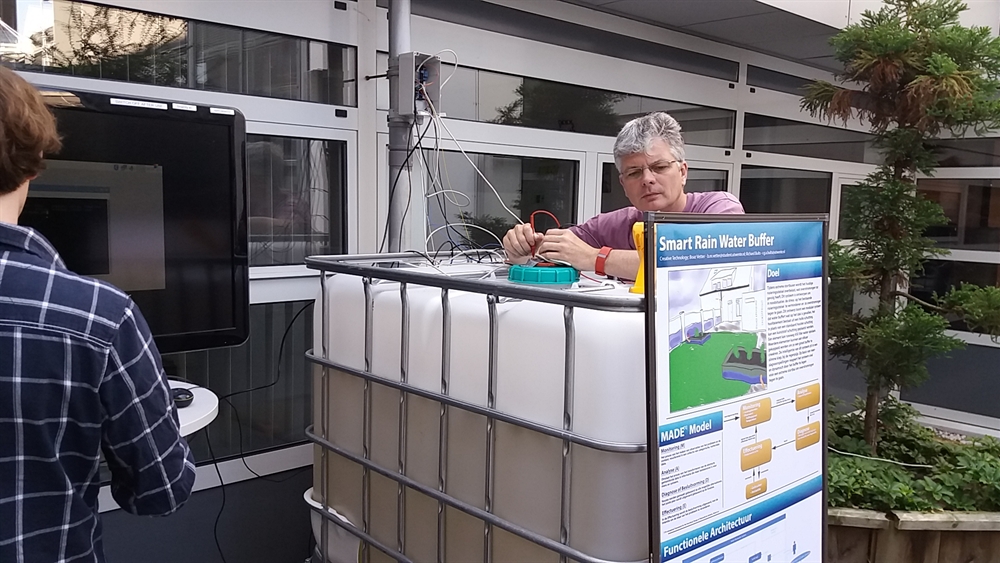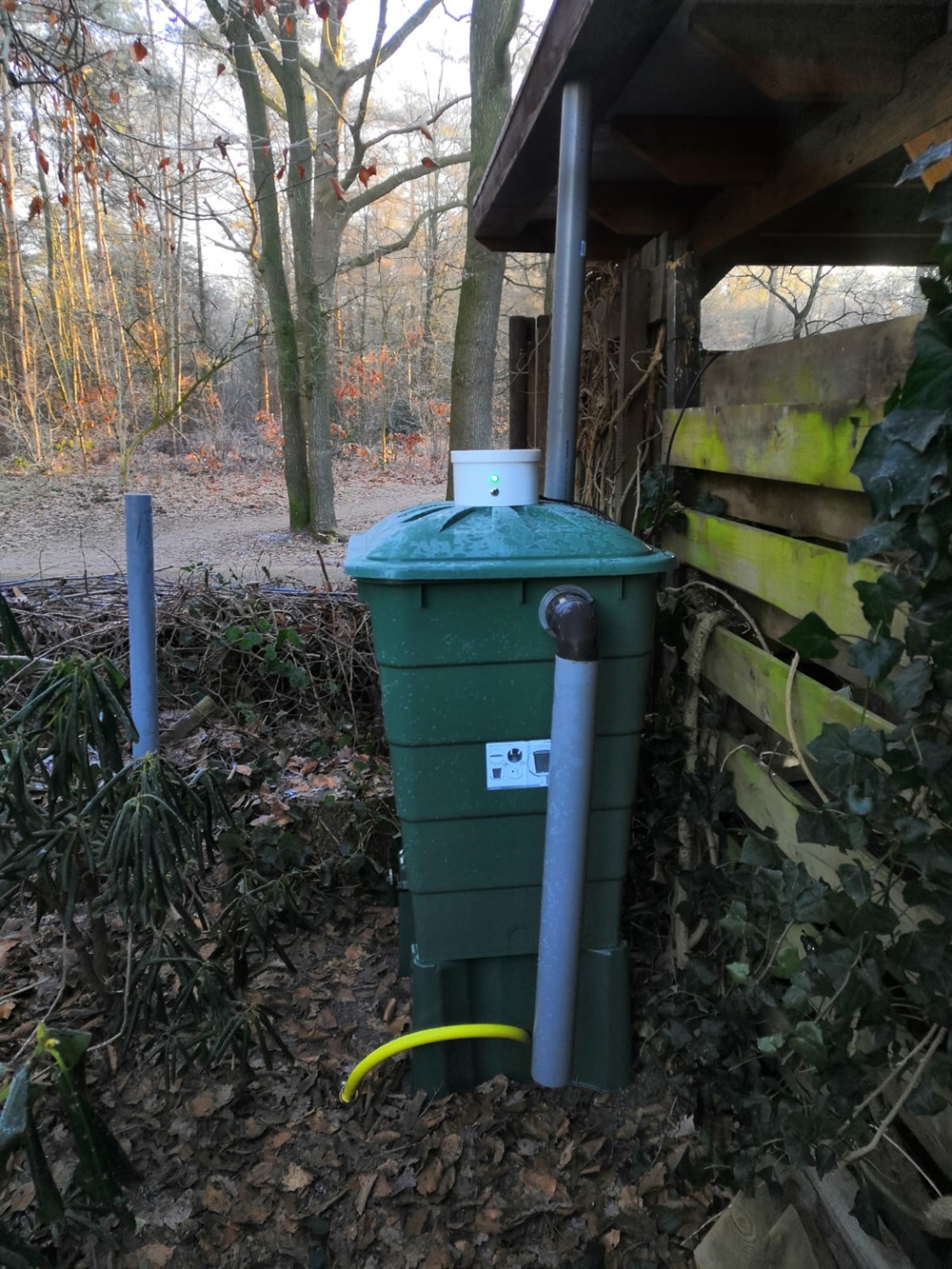The Rain Tower: a network of smart rainwater buffers on private property
The municipality of Enschede is conducting a pilot study into the substantiation of rainwater management in the city, in collaboration with residents. To this end, the municipality of Enschede, Twente University, and the Vechtstromen district water board are developing the “Rain Tower”: a network of smart rainwater buffers at private homes.
Additional water storage, raising awareness
In order to be able to store extreme rainfall, the municipality of Enschede is investing a sum of 6.3 million euros in a 7,000,000 litre water storage facility located in the city centre. Additional storage capacity is required to continue to prevent waterlogging under future climate conditions. Additional rainwater buffers at carefully selected locations will increase the return on investment when the climate changes. However, the municipality is unable to realise such additional capacity on its own. It is essential for private individuals to store water as well, as 70 per cent of the rainwater discharged by the sewer system originates from private property.
This prompted the municipality of Enschede to develop the “Rain Tower”, in collaboration with Twente University and the Vechtstromen district water board: a network of smart rainwater buffers that collectively provide additional water storage. A buffer comprises a rainwater tank and a computer-controlled system that uses a weather forecast to determine when to empty the buffer in order to subsequently be able to store (fresh) rainwater. With the rain tower, the parties are not just hoping to substantially expand the water storage capacity, but also to raise rainwater and groundwater awareness among private individuals.
From Creathon to Pilot
The idea for the smart rainwater buffer arose in mid-2016 during the Twente creathon on urban climate effects. A creathon is a format involving students working on solutions to a societal problem for twenty-four hours in a row. The idea named the “Ensketon” was conceived by Creative Technology students of Twente University.
The Ensketon idea was subsequently elaborated in several graduation projects within the Creative Technology programme. These projects showed that, from a technological perspective, it was feasible to develop a working prototype of a smart rainwater buffer and have it respond to a weather forecast: when extreme downpours are expected, the buffer will empty itself (into the garden or the sewer system), thus creating additional water storage. The prototype which was developed turned out to enthuse residents. The positive results encouraged the parties to set up the “Rain Tower” project.

Image: Prototype of 500-litre rainwater buffer (© Hendrikjan Teekens, 2017)
Hendrikjan Teekens: With this project, we are substantiating the Enschede Lab, an organisation aiming to have students work on societal issues in the city in which their university is located. In our experience, students tend to prefer such topics: what they come up with is actually implemented in the city. Businesses located at the Science & Business park next to the University are also involved in this project. Many of their staff are alumni of the University.
Rain Tower pilot: twenty-five residents testing the smart rainwater buffer
In early 2019, the project partners launched a pre-pilot at the homes of seven project participants. Their intention is to conduct a pilot at twenty-five private homes, starting in mid-2019. Their gardens will be equipped with a smart rainwater buffer with a capacity of 250 litres. If this pilot bears fruit, a second pilot will be launched in 2020, involving an XXL version of the buffer (featuring a capacity of 20,000 litres). This XXL version should be suitable for business premises.

Image: 250-litre rainwater buffer for the pre-pilot (© Hendrikjan Teekens, 2019)
The 2019 pilot will involve a quarterly evaluation of the performance of the smart rainwater buffer, with the participants. Any adjustments required will be implemented immediately, if possible. The 2019 pilot is intended to further develop the Rain Tower concept and prepare for its large-scale introduction in 2020-2025. The main questions to be researched during the 2019 pilot are:
- How can the rain barrel be properly adjusted to the weather forecast? Experience teaches that showers can develop differently at the last minute. In such cases, the barrel can let the water go whilst the shower passes or vice versa.
- Sewerage involves a robust and low-maintenance system featuring high operational security. In principle, the rain tower system must meet these same requirements. How can this be achieved?
- What insights into the use of their smart rainwater buffer do residents want?
- What insights into the performance of the network of smart rainwater buffers do the municipality of Enschede and/or the Vechtstromen district water board want?
- To what extent does the “Rain Tower” contribute to the rainwater storage tasking in Enschede? (The municipal buffers will start to operate once the sewer system has reached its maximum processing capacity and water is threatening to flow into the streets, whereas the private buffers will start to operate before any rain has fallen.)
In addition to exploring the performance of smart rainwater buffers, the 2019 pilot serves several other purposes:
- Preparing the smart rainwater buffer for private individuals and businesses;
- Setting up a targeted publicity campaign to promote the acceptance and adoption of smart rainwater buffers;
- Elaborating an organisational format for the realisation of the “Rain Tower” featuring thousands of smart rainwater buffers;
- Incorporating the additional private storage capacity into the municipal sewerage data.
Future perspective for the Rain Tower
The outcomes of the pilot studies will be used to explore, in 2020, whether the municipality can promote the use of smart rainwater buffers, for example, by selling them at a discount.
Businesses can then opt for the XXL version and thus contribute to the municipal rainwater storage tasking. Scale size is important to the success of the rain tower. Obviously, the larger the collective capacity of the rainwater buffers, the greater their contribution to the solution. Industrial estates hold a considerable potential for realising large buffers. Buffers with a capacity of 1,000,000+ litres can make a significant contribution to the reduction of waterlogging. If the XXL version is a success, the overall storage capacity to be realised may run up to 3,000,000 litres.
In addition to the combating of waterlogging, the parties involved also view other applications for the Rain Tower. For example, during dry weather with low groundwater levels, the water can be used for the irrigation of plants and trees, thus combating dehydration. Individual rainwater buffers can thus boost both rainwater and groundwater awareness among private residents.
Furthermore, the XXL version of the smart rainwater buffer could become an aesthetic eyecatcher in the public space, when artists and designers are recruited to assist on the project.
Costs of public versus private solutions
The costs of public water storage amount to approx. one euro per litre. If the Rain Tower is a success, the municipality could calculate to what extent the private storage facilities contribute to the public storage capacity. This could generate another perspective of the comparative assessment of future private versus public investments.
Lessons to be learned from the project
Ten years ago, the municipal water tasking mainly focused on the subsoil: the sewer system. Enschede is where the wadis were invented in 1992, an above-ground substantiation of rainwater management. Water storage in the public space is generally accepted nowadays. With the development of the rain tower, we are entering a new phase: water storage at the location where the rain falls, in private gardens and on business premises.
Contact persons
Richard Bults
University of Twente / Creative technology
Smart XP supervisor
r.g.a.bults@utwente.nl
+31618965627
Hendrikjan Teekens
Ontwerper water
Gemeente Enschede
Hj.teekens@enschede.nl
+31613168686
Jeroen Buitenweg
Beleidsmedewerker Waterschap Vechtstromen
j.buitenweg@vechtstromen.nl
+3121882326
